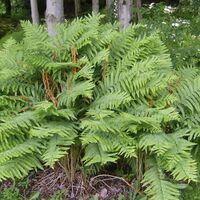Cinnamon Fern
Osmunda cinnamomea, more commonly known as the Cinnamon fern, is a deciduous perennial fern [4]. It looks very similar to the Interrupted, Royal, and Sensitive ferns because of its composition, but using the reproductive fronds you can tell them apart [1]. The Cinnamon fern has cinnamon-colored fiddleheads specially used for reproduction, and that's where it gets its name [1].


Taxonomy
| Kingdom | Phylum | Class | Order | Family | Genus | |
|---|---|---|---|---|---|---|
| Classification | Plantae | Filicinophyta | Filicopsida | Filicales | Osmundaceae | Osmunda |
Description

Cinnamon ferns have long green fronds that are typically 2-3' in length but can reach up to 6' [5]. The blades of these fronds are pinnate, which means they share a common axis from which the pinna or the leaflets will grow [1]. Leaflets are deeply lobed, come to a point, and are about ten inches in length [1]. This fern likes to grow in groups or clumps in very moist environments [5]. During the spring, spore-bearing fronds will develop on this plant, these are known as "fiddleheads" [5]. These fiddleheads emerge from the base of the fern for reproduction [5]. Fiddleheads on Cinnamon ferns are anywhere from 2-4' long, are very stiff, and have a yellow-greenish color [5]. On the outside of these reproductive fronds, there are small cinnamon-colored balls. These are their sori and sporangium [3].
Reproduction

During the springtime, ferns will produce fertile fronds known as "fiddleheads" [5]. These fiddleheads are covered with sori and have the sole purpose of reproduction [1]. This fern becomes fertile in May and ends its reproductive period in June [4]. Ferns reproduce differently from other plants; they have a sporophytic life cycle [2]. First, the sporangium from a mature adult plant will open and release the egg and hopefully get find male sori to start the germination process [2]. After the first fertilization, the zygote begins to become a gametophyte/Prothallium. Once the Prothallium has matured it will undergo a second fertilization [2]. This second fertilization will mark the beginning of the Cinnamon ferns' journey to maturity and the cycle can begin again [2].
Range and Habitat
Cinnamon ferns are primarily found in the Eastern United States and Canada, although have been found in gulf coast states, like New Mexico [1]. Like all ferns, the Cinnamon fern likes very moist, acidic, and shady soils [1]. This plant typically likes wetland environments such as swamps, marshes, and wet forests [1]. This plant is slow to establish itself, but once it does it is long-lived [5]. If the soil becomes too dry this fern may go dormant until conditions are moist again [5].
Uses
The Cinnamon fern is not used as a food source by any wildlife, but it does have uses. Parts of this fern are used by Warblers and hummingbirds for their nests [1]. Brown Thrashers and Veeries are reported to live in the base of this fern and claim it as their nest [1]. In the past Cinnamon ferns have been used by the Abnaki and Menominee Native Americans for food and medicinal purposes [1]. They used a concoction of root material and rubbed it into affected joints to relieve pain [1].
References
[1] Adirondack Ferns: Cinnamon Fern | Osmundastrum cinnamomeum. (n.d.). . https://wildadirondacks.org/adirondack-ferns-cinnamon-fern-osmundastrum-cinnamomeum.html.
[2] Australian National Botanic Gardens, P. A. (n.d.). Growing ferns from spores - Australian Plant Information. https://www.anbg.gov.au/ferns/fern.spore.prop.html#:~:text=Ferns%20do%20not%20flower%20but,shaped%20plants%20known%20as%20prothalli.
[3] Cinnamon Fern & Interrupted Fern | Mountain Lake Biological Station, U.Va. (n.d.). . https://mlbs.virginia.edu/organism/cinnamon-interrupted-ferns#:~:text=Besides%20sexual%20reproduction%2C%20the%20ferns,cinnamon%20%E2%80%9Cfruiting%20bodies%E2%80%9D).
[4] Lady Bird Johnson Wildflower Center - The University of Texas at Austin. (n.d.). . https://www.wildflower.org/plants/result.php?id_plant=OSCI.
[5] Osmundastrum cinnamomeum (Cinnamon Fern) | North Carolina Extension Gardener Plant Toolbox. (n.d.). . https://plants.ces.ncsu.edu/plants/osmundastrum-cinnamomeum/.